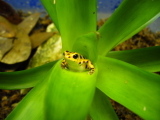|
| 질의: Forest frog | 결과: 20번째/188 | |
Poison Dart Frog (Family: Dendrobatidae) - Wiki
| 제목: | Poison Dart Frog (Family: Dendrobatidae) - Wiki
| |

| 해상도: 160x120
파일크기: 39744 Bytes
촬영일: 2007:02:21 10:20:44
사진기: DMC-LZ5 (Panasonic)
F number: f/2.8
Exposure: 10/200 sec
Focal Length: 61/10
등록시간: 2007:08:29 21:42:19
|
Poison dart frog
From Wikipedia, the free encyclopedia
[Photo] Strawberry Poison-dart frog, Dendrobates pumilio. Bastimentos Isle female pumilio resting in the axil of a Guzmania hybrid bromeliad. Author: Mason Moreland
The poison dart frog (also poison arrow frog, dart frog or poison frog) is the common name given to the group of frogs belonging to the family Dendrobatidae. Poison dart frogs are native to Central and South America. The frogs are widely called poison arrow frogs or poison dart frogs, reflecting the widespread notion that the frogs are used by South American tribes in the manufacture of poison that is spread on arrows or blow-gun darts.
Dart frogs are not venomous in captivity. Scientists believe that this is due to the fact that they do not receive alkaloids as food because they are fed with cultured insects. These frogs are some of the world's most poisonous living organisms; one drop of venom could be powerful enough to kill 80 people.
Background
Poison dart frogs are a group of small, diurnal, and often brightly colored frogs native to Central and South America. They are not "venomous" at all, as is stated in the above section. In the wild they are "poisonous". The difference is that poison is injested and venom must be injected into the body. These frogs received their common name from the numerous types of poisonous alkaloids found in the skin of many species. The most poisonous dart frog is the Golden Poison Dart Frog (Phyllobates terribilis).
Many poison dart frogs have brightly colored skin and are small. The skin color can range from bright orange and black to blue or yellow. However, members of the most species-rich genus, Colostethus, are generally brown. Poison dart frogs range in size from 1 centimeter (0.4 in) to 6 centimeters (2.5 in) in length, depending on the age and species of the frog.
Reproduction and Parental Care
In most species, eggs are laid near the forest floor by the female, usually in a sheltered and moist spot. One parent (generally the male) guards the eggs until they hatch. The newly hatched tadpoles wriggle onto the back of either the male or female parent, who transports them to water, often a small pool or the water trapped in the axil of a Bromeliad plant.
In some species, the female returns to the tadpoles repeatedly to lay infertile eggs for them to feed upon. In a few species this is the only source of food for the tadpoles until they undergo metamorphosis into sub-adult froglets; these species are called 'obligate egg feeders'. Obligate egg-feeding species can be especially difficult to rear in captivity.
Poison frogs in captivity
In captivity, poison dart frogs have a lifespan of 5 to 12+ years, but little data exists for wild frogs. Poison dart frogs are commonly bred in captivity to be non-toxic. Most species reach maturity around 1.5 to 2.5 years of age.
The easiest way to determine the sex of a particular species of poison dart frog is by observation in the wild. Mature male frogs will usually make a mating call after eating or after a heavy misting of water. The sound is similar to that of a series of high-pitched "clicks". In juvenile frogs the sex can sometimes be determined by the profile of the amphibian. The backs of males usually slope down with less of a break than females. Females are usually rounder and show a bigger break.
Another simpler way to sex these frogs is by their toes. A female dendrobates will have narrow toes all the way down and a male's toes get very wide at the ends. Mature males also show a small section of grey skin on their neck. This is where the mating call is produced.
In captivity, most species thrive where the humidity is kept constant at 80-100% and where the temperature is around 75-80 F degrees (24-27 °C) during the day and no lower than 60-65 F degrees (16-18 °C) at night.
Color morphs
Some species include a number of sub-species 'morphs'. Different morphs represent geographically separated populations of the same species in the wild, showing different coloration. For example, the species Dendrobates tinctorius includes at least a dozen morphs.
http://en.wikipedia.org/wiki/Poison_dart_frog
| The text in this page is based on the copyrighted Wikipedia article shown in above URL. It is used under the GNU Free Documentation License. You may redistribute it, verbatim or modified, providing that you comply with the terms of the GFDL. |
|
^o^
동물그림창고 똑똑전화 누리집
^o^
|
|

